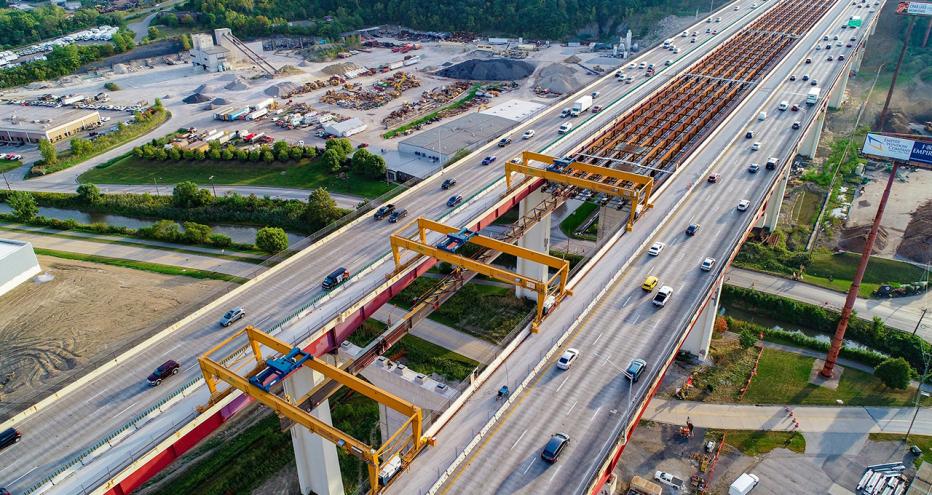
Carefully placing a new four-lane, 4,150-foot structure between existing structures sounds like an engineer’s version of Tetris, but that’s exactly what the Ohio Department of Transportation (ODOT) accomplished on the I-480 Valley View Bridge project in the Cleveland metro area.
ODOT built the two existing I-480 Valley View bridges across the Cuyahoga River Valley in the 1970s, purposely leaving just enough room between them for a third bridge to be built in the future.
And, the future is now.
When ODOT determined the existing bridge decks had reached the end of their useful life and began planning for replacement, a new center bridge was deemed necessary to maintain full capacity on this segment of I-480 that serves over 180,000 vehicles daily.
Beginning September 13, a newly-completed, 15-span, four-lane steel-girder “center” bridge allows I-480 — one of the busiest freeways in Ohio — to continue to operate at full capacity while the two existing structures are alternately rehabilitated over the next two years. After rehabilitation and deck replacement of the existing structures is completed, the new center bridge will add two permanent lanes to I-480 in each direction and help reduce congestion through this heavily traveled area.
Better Driving in the Buckeye State
“Knowing quality of life, commute times and taxpayer funds were at stake, Jacobs developed an innovative foundation design and performed extensive analysis to erect the new center bridge up to 200 feet above the Cuyahoga River Valley using gantry cranes spanning between the existing structures,” explains Jacobs’ Project Design Manager Mark Maday. “Partnering with ODOT and Walsh Construction, we lowered construction costs and facilitated construction of the new center bridge on an accelerated schedule without any recordable safety incidents.”
“I’m proud of what the Valley View Bridge team has been able to accomplish over the last three years in designing and constructing the new center bridge structure,” says ODOT District 12 Construction Project Manager/Area Engineer Kirk Gegick. “The team has worked together to overcome design and construction challenges and was not delayed even through a global pandemic. Maintaining a strong partnering relationship between ODOT and the design-build team, has been instrumental in reaching this project milestone.”
You Have to See it to Believe it
Because of the height and limited space between the existing bridges, using traditional ground mounted cranes to place the new I-girders wasn’t possible. Erection of the nearly 5.5 miles of new steel I-girders was completed using three gantry cranes spanning transversely between the existing structures. Gantry hoists lifting each girder segment were carefully controlled and continuously adjusted to equally distribute the lifting load among the three gantries before they transported each girder segment to its designated location in the new bridge. A total of 203 such girder “picks” up to 300-feet-long, were required to build the new structure. If it sounds hard to imagine, see for yourself.

Laying the Foundation for Success
The unique foundation design, proposed by Jacobs, involved installing test piles at the site of each foundation and then measuring the capacity strength gain of those piles over a period of weeks. Ultimately, we were able to reduce the total number and length of piles required to support the center bridge foundation load. Doing so saved significant construction cost due to reduced pile quantities, and also saved significant time during installation since installing large diameter piles to significant depths is a time intensive operation. Overall this approach saved millions of dollars.
Want more impressive details about this project? Click here.














































